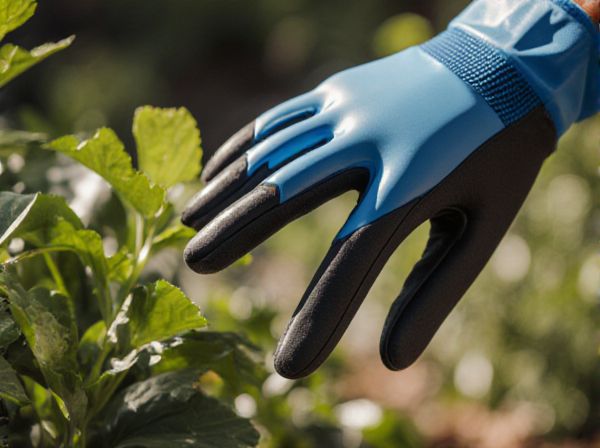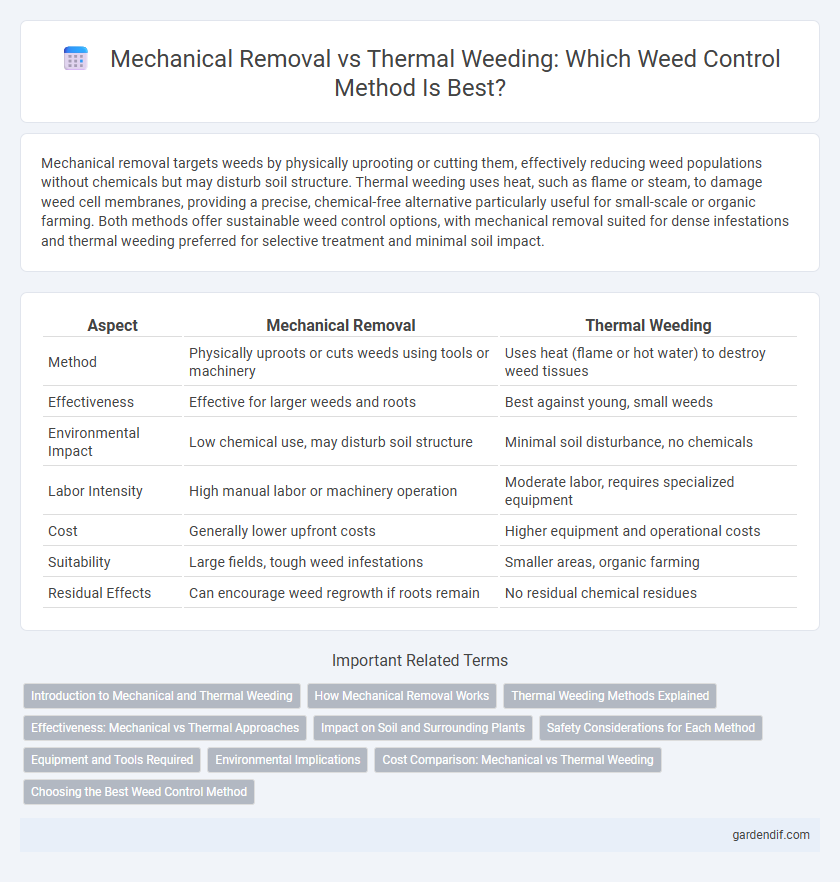
Mechanical removal vs Thermal weeding Illustration
Mechanical removal targets weeds by physically uprooting or cutting them, effectively reducing weed populations without chemicals but may disturb soil structure. Thermal weeding uses heat, such as flame or steam, to damage weed cell membranes, providing a precise, chemical-free alternative particularly useful for small-scale or organic farming. Both methods offer sustainable weed control options, with mechanical removal suited for dense infestations and thermal weeding preferred for selective treatment and minimal soil impact.
Table of Comparison
| Aspect | Mechanical Removal | Thermal Weeding |
|---|---|---|
| Method | Physically uproots or cuts weeds using tools or machinery | Uses heat (flame or hot water) to destroy weed tissues |
| Effectiveness | Effective for larger weeds and roots | Best against young, small weeds |
| Environmental Impact | Low chemical use, may disturb soil structure | Minimal soil disturbance, no chemicals |
| Labor Intensity | High manual labor or machinery operation | Moderate labor, requires specialized equipment |
| Cost | Generally lower upfront costs | Higher equipment and operational costs |
| Suitability | Large fields, tough weed infestations | Smaller areas, organic farming |
| Residual Effects | Can encourage weed regrowth if roots remain | No residual chemical residues |
Introduction to Mechanical and Thermal Weeding
Mechanical weeding employs physical tools such as hoes, cultivators, and rotary tillers to disrupt weed growth by uprooting or cutting weeds. Thermal weeding utilizes heat sources like flame burners, hot water, or steam to damage weed cells and prevent regrowth without soil disturbance. Both methods offer effective, chemical-free alternatives for weed control in sustainable agriculture and horticulture.
How Mechanical Removal Works
Mechanical removal of weeds involves physically uprooting or severing plants using tools like hoes, cultivators, or specialized machinery designed to disrupt weed growth at the soil level. This method targets weed roots and stems directly, preventing regrowth by eliminating the plant's ability to absorb nutrients and water. Unlike thermal weeding, mechanical removal promotes soil aeration and can be precisely controlled to minimize crop damage while effectively managing invasive weed populations.
Thermal Weeding Methods Explained
Thermal weeding methods include flame weeding, steaming, and hot water treatment, which target weed tissues by applying heat to disrupt cell membranes and cause desiccation. These techniques offer eco-friendly alternatives to chemical herbicides, effectively controlling weeds without soil disturbance or chemical residues. Efficient thermal weeding reduces weed seed germination and minimizes labor costs, proving valuable in organic farming and sustainable agriculture practices.
Effectiveness: Mechanical vs Thermal Approaches
Mechanical removal of weeds excels in physically uprooting or cutting plants, providing immediate control especially for large or dense infestations, but may leave roots intact leading to regrowth. Thermal weeding utilizes heat sources such as flame or microwaves to damage weed cells, offering a chemical-free option that effectively targets young seedlings and surface weeds with rapid results. Effectiveness varies by weed species and growth stage; thermal methods often require repeated treatments for established weeds, whereas mechanical removal can be more labor-intensive but ensures root disruption.
Impact on Soil and Surrounding Plants
Mechanical removal disturbs soil structure, potentially leading to erosion and disruption of beneficial microorganisms, while thermal weeding uses heat to kill weeds without significant soil disturbance. Thermal weeding minimizes damage to surrounding plants by targeting weeds selectively with precise application, whereas mechanical removal can harm nearby vegetation due to physical contact. Soil health benefits from thermal weeding's reduced compaction and preservation of soil organisms, promoting sustainable weed management practices.
Safety Considerations for Each Method
Mechanical removal of weeds involves physical tools such as hoes, tillers, or hand-pulling, posing minimal chemical exposure but higher risk of injury from repetitive motion or sharp implements. Thermal weeding uses flame or steam to kill weeds, requiring careful handling of heat sources to prevent burns, fire hazards, and damage to surrounding plants. Proper training and protective equipment are essential in both methods to ensure safe operation and minimize health risks.
Equipment and Tools Required
Mechanical removal of weeds relies on equipment such as hoes, rotary tillers, and cultivators, which physically uproot or disturb the weeds. Thermal weeding utilizes tools like propane torches, infrared weed control systems, and hot water applicators to apply heat directly to weed foliage, causing cellular damage. Both methods require specific machinery suited to the scale of application, with mechanical tools often favored for soil-based weed disruption and thermal equipment preferred for chemical-free, precise weed management.
Environmental Implications
Mechanical removal of weeds involves physical extraction, minimizing chemical use and preserving soil biodiversity, but may cause soil disturbance leading to erosion risks. Thermal weeding applies heat to eliminate weeds, reducing herbicide dependency and chemical runoff, though it can affect non-target organisms and soil microorganisms. Choosing between methods requires assessing local ecosystem sensitivity and long-term soil health impact to ensure sustainable weed management.
Cost Comparison: Mechanical vs Thermal Weeding
Mechanical weeding typically incurs lower upfront costs due to simpler equipment and lower energy requirements, making it more accessible for small-scale farmers. Thermal weeding demands higher initial investment in specialized machinery and fuel or energy input, which can increase operational expenses despite reducing labor costs. Over time, the cost-effectiveness of each method varies based on farm size, weed pressure, and fuel prices, with mechanical removal favored for budget-conscious operations and thermal weeding appealing for precision and reduced chemical use.
Choosing the Best Weed Control Method
Mechanical removal targets weeds by physically uprooting or cutting them, offering an eco-friendly solution that reduces chemical dependency and promotes soil health. Thermal weeding uses intense heat to destroy weed cells, providing rapid, chemical-free control especially effective in organic farming systems. Selecting the best weed control method depends on factors like weed species, crop type, environmental impact, and long-term sustainability goals.
Mechanical removal vs Thermal weeding Infographic

 gardendif.com
gardendif.com